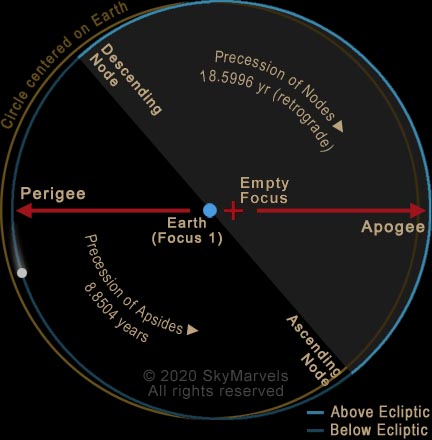
MOON ORBIT VARIABILITY
Video Attribution:
Author: Phoenix7777 Date: 3 November 2018 Source: Own work
Data source: HORIZONS System, JPL, NASA
Used under Creative Commons Attribution-Share Alike 4.0 International license.
POLAR VIEW EQUATORIAL VIEW


Though the Moon's orbit—in conformance with Kepler's Laws—is essentially elliptical, its overall shape is neither constant nor a "simple ellipse". In fact, it is a striking example of how drastically other celestial objects and the shape of a "parent object" can affect a natural satellite's motion.
The two intriguing animations above reveal the lunar orbit's considerable variability. Rather than continually tracing the same path around Earth (  ), our Moon (
), our Moon (  ) has an orbit that "wobbles" around our planet! In addition, its orbital minimum and maximum distances from Earth (at perigee and apogee respectively) both change constantly and to a significant degree.
) has an orbit that "wobbles" around our planet! In addition, its orbital minimum and maximum distances from Earth (at perigee and apogee respectively) both change constantly and to a significant degree.
 The considerable variability of the lu- nar orbit is the result of the perturbing gravitational forces of the Sun, the planets (especially mighty Jupiter), even Earth's equatorial bulge. These cause the Moon's orbital plane (and likewise, therefore, the orbit's Line of Nodes) to precess (rotate) backwards (i.e. in a retrograde direction) about every 18 1/2 years! The same forces also cause the lunar orbit's Line of Apsides (line from perigee to apogee) to precess forward (prograde) almost every 9 years! Moreover, as the an- imation above dramatically reveals, the Moon's distances of perigee and apogee vary over appreciably shorter spans of time. This means that the region "where the Moon may wander" is actually a donut-shaped volume encircling Earth! The image directly below displays a cross-section of a
The considerable variability of the lu- nar orbit is the result of the perturbing gravitational forces of the Sun, the planets (especially mighty Jupiter), even Earth's equatorial bulge. These cause the Moon's orbital plane (and likewise, therefore, the orbit's Line of Nodes) to precess (rotate) backwards (i.e. in a retrograde direction) about every 18 1/2 years! The same forces also cause the lunar orbit's Line of Apsides (line from perigee to apogee) to precess forward (prograde) almost every 9 years! Moreover, as the an- imation above dramatically reveals, the Moon's distances of perigee and apogee vary over appreciably shorter spans of time. This means that the region "where the Moon may wander" is actually a donut-shaped volume encircling Earth! The image directly below displays a cross-section of a
portion of this region.

Toward the right in the diagram directly above, a few actual examples from 2020 highlight the variability of 1) the Moon's distance from Earth, and 2) its distance above or below the Ecliptic (Earth's orbital plane). The Lunar Orbit: View from the Sun interactive can verify how far above or below the Ecliptic the Moon is today, as well as for the entire year. And the excellent online app Moon Phaser lets you find the orbital position of the Moon on any date.
The zoomed-out diagram below, looking down on the Moon's entire orbit, makes it easier to appre- ciate the proportions of the torus-shaped (donut-shaped) region "where the Moon may wander". A cross-section of this region is roughly 4 (four) Earth diameters wide and roughly 6 (six) Earth diameters high So, overall, the proportions of the region "where the Moon may wander" are similar to those of a fairly typical wedding band! Many of us married persons never realized we were carrying around a pretty good model of the Moon's orbit!

Because its distance from Earth determines how large our nearest celestial neighbor looks in our skies, the Current "Relative" Apparent Sizes of the Sun & Moon displays our lunar companion from an intriguingly comparative perspective. Moreover, with the scrollable image below, you can likewise verify the inconstant lunar perigee and apogee distances, and that they change over much shorter intervals than the precessions of the lunar orbit. These continual variations of the lunar perigee and apogee are not insignificant. When the Moon's perigee nears its lower limit, for example, the resulting Perigean Tides can be extreme, substantially aggravating shore erosion.

Supermoons & Extreme Perigean Tides 2020-2022
You can use the Lunar Perigee and Apogee Calculator to examine centuries of how the Moon's least and greatest distances from Earth vary from month to month. And with the awesome online app Gravity Simulator you can study the intriguing lunar orbit by changing a host of parameters. Note that Gravity Simulator's trails—which can be turned off and on near the top—likewise show which parts of each lunar orbit are above and below the Ecliptic. In addition, the simulator's bary- center can be toggled off and on toward the left. Very cool! Very enlightening!
Home Intro News Gallery Sky-Gifts Bonuses Tips
Learning Ctr Help Links Credits Legal Contact Us
© 2007-
by Gary M. Winter. All rights reserved.
Interested in political cartoons and humor?
Check out The HIPPLOMATS™.


